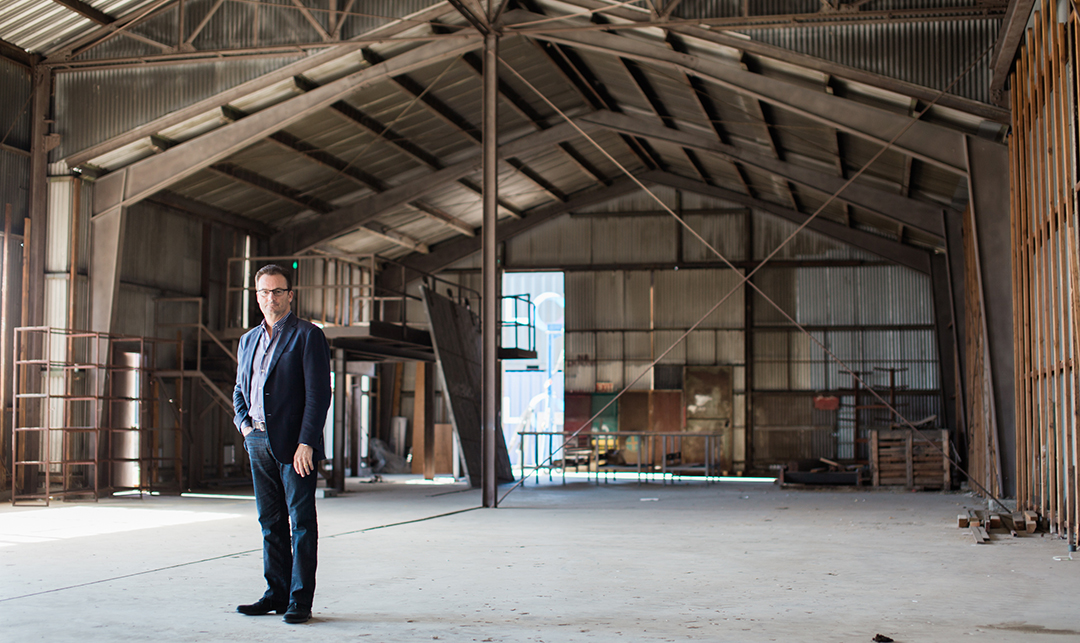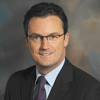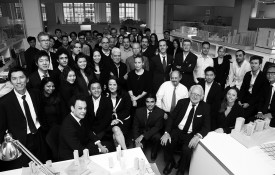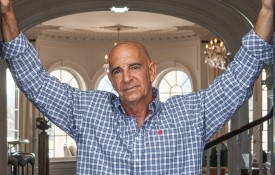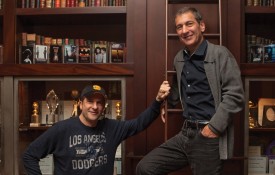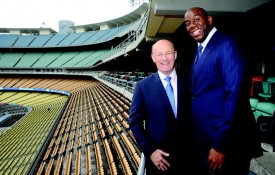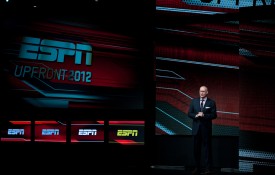From the outside, the Downtown Los Angeles headquarters of Hyperloop Technologies is unassuming. Without knowledge of the mission of those behind closed doors, one might assume it was another auto parts manufacturer or retail distribution center south of the arts district. Yet inside the modern brick and steel offices, the team behind Hyperloop Technologies is building what may be the future of transportation.
In layperson’s terms, the concept of Hyperloop is to significantly increase the speed and efficiency of transportation by placing people and shipments in secure pods and hurtling them through pressure-reduced steel tubes at hundreds of miles per hour. On Hyperloop’s “Hype” video on YouTube, Director of Operations Erica Kearns states, “Live anywhere, work anywhere, be anywhere,” and in Los Angeles alone, where both the cost of living and the effect of congested traffic are major life considerations, the message resonates.
When learning about it for the first time, many have compared the concept of Hyperloop to something out of The Jetsons, says CEO Rob Lloyd, but the concept has been around for years for many uses such as in healthcare when pneumatic tubes are used to send medicine from the pharmacy to the hospital floor.

The Blade Runner, a system to test compressor designs in ultra low-pressure environments
Constructing an Infinite Reality
“HYPERLOOP IS REAL,” the company’s website boldly proclaims. Perhaps this is a reference to past promises of high-speed rails and public transportation schemes with much fanfare and no fruition throughout the decades in Los Angeles. Either way, what was first a glint in Elon Musk’s eye is now on the verge of reality.
Despite reference to such futuristic methods of transport in cartoons and science fiction, the concept behind Hyperloop was initially the brainchild of Elon Musk, who mentioned it in confidence to his friend, serial entrepreneur and venture capitalist Shervin Pishevar. Musk suggested that this potential fifth mode of transportation (after cars, planes, trains, and boats) would be a cross between a Concorde, a railgun, and an air hockey table. Musk would go on to publish a 53-page paper on the subject for public consumption in 2013; Pishevar took the idea and ran with it.
“Everybody wants transportation to be better,” states Lloyd. “No one is happy with what we have today.” As a city, there is perhaps no more fitting canvas than Los Angeles to vividly illustrate that point.
While the spotlight is typically trained on the large entertainment brands that occupy the city, often overlooked is the fact that LA is home to more aerospace and defense companies—Boeing, Northrop Grumman, and Raytheon among them—than anywhere else in the country. Add Elon Musk’s SpaceX (Hawthorne) and Hyperloop Technologies to the mix, and the city is becoming not only a vibrant tech scene, but a base for the future of space-age transportation.
Pishevar recruited former SpaceX engineer Brogan BamBrogan to co-found the company and act as chief technology officer. BamBrogan then recruited Josh Giegel, another SpaceX aerospace engineer, to join the team. An all-star board of directors, including Peter Diamandis, founder, CEO, and chairman of XPrize; David O. Sacks, founder of Yammer, former COO of PayPal, and current COO of Zenefits; Palantir Founder Joe Lonsdale; former White House Deputy Chief of Staff Jim Messina; and former Snapchat COO Emily White. As of December 2015, the staff includes 70 engineers working in their three-acre campus and is expected to grow substantially in 2016.
“The entire market for transportation – freight transportation, the movement of people, and the technologies that enable that on an annual basis – is almost $5 trillion.”
They still needed a strong business leader to collaborate with BamBrogan and ensure the company stayed focused on the right priorities with so many things to accomplish, so Pishevar recruited Lloyd, former President of $50B tech giant Cisco Systems. Lloyd recalls their first conversation about Hyperloop Technologies. “When I mentioned that I was leaving Cisco, Shervan exclaimed, ‘Change the world with me!’ And I said, ‘What does that mean?’ He said, ‘Come to our board meeting tomorrow in San Francisco at 11 a.m. and find out.’” Intrigued, Lloyd made the trip. Upon his return home, Lloyd discussed the idea with his family. The consensus was that if he was going to do anything next, this should be it.

Hyperloop co-founder and CTO Brogan BamBrogan
From his 21-year tenure with Cisco, Lloyd brings the knowledge of how to run global sales and engineering teams, but also vital expertise in building large, complex multi-billion dollar projects with companies and governments around the globe. He also sees similarities between his experience at Cisco – where the objective was to develop a global network moving all forms of data at high speeds – to a new network that will move atoms at a pace that will redefine distance and time.
The Promise of Hyperloop
Hyperloop has the potential to impact our cost of living, traffic congestion, shipping, and point-to-point travel with far reaching implications. “Suddenly there is no distinction between where we can afford to live and where we chose to work,” Lloyd states. “You can live where you want to live, and choose where you want to work, and the impact on labor markets completely transforms.” He also notes that Hyperloop will be capable of moving large volumes of containers arriving on huge ships directly from our clogged ports to a dry port, perhaps 100 miles inland. This could free up valuable land consumed by ports in coastal communities around the world. “It’s a really big deal, people and cargo and the impact it can have.” This is just scratching the surface of the massive potential of Hyperloop, but first it will take a lot of work to navigate the challenges of building out the infrastructure.
To date, the company has raised $37M and is on track to close its $80M Series B round of funding. While an LA to San Francisco trip aboard Hyperloop would take a scant 30 minutes, the cost of completing such a track has been estimated at $8B. As a first step, the company announced in December that its first test track will be constructed on 50 acres just north of Las Vegas, Nev., with testing to begin in 2016.
More dynamic than air or rail travel, Hyperloop can make multiple stops between major markets, and at a much higher speed. “Hyperloop is one of those ideas that could disrupt massive markets of physical technologies,” says Lloyd, noting that while with Cisco, the addressable market for networking technology was pretty large at around $250B. “That’s a really big market,” he acknowledges, before adding a new layer of perspective. “The entire market for transportation – freight transportation, the movement of people, and the technologies that enable that on an annual basis – is almost $5 trillion.”
“Suddenly there is no distinction between where we can afford to live and where we chose to work … you can live where you want to live, and choose where you want to work, and the impact on labor markets completely transforms.”

Route analysis system that illustrates propulsion and transportation speeds for various corridors (Photo: Dennis Roy Coronel)
Lloyd suggests that the two biggest challenges ahead will be ensuring (a) ongoing regulatory approval and (b) raising project capital at the speed necessary to take advantage of global opportunities. “This idea exists of a global movement that wants something different and better, a movement that could put pressure on regulators and politicians that says, ‘Why don’t we have Hyperloop in our country when another country just got it? Why are we dealing with this antiquated technology? Why don’t we have a modern infrastructure?’” Lloyd posits.
The first real hurdle to making both regulatory and capital goals easier will be what the team calls its “Kitty Hawk moment,” a reference to the town in North Carolina where the Wright brothers achieved the first successful airplane flights. In this case, the goal is to pull off the first successful test at scale of a full-sized pod shooting through a full-sized tube and prove that the system is capable of safely moving at ultra-fast speeds in a pressure-reduced environment.
The target is to show a successful test by the end of 2016. The team will first focus on moving freight, then turn its attention to safely transporting people. From 2017 to 2020, they hope to confirm three projects in selected locations around the world – fully supported by senior government officials, politicians, and regulators – that will allow them to move quickly. They plan to fund those projects with a mix of private and public funds, start those projects in 2017, and complete them over the next several years. In five years they hope to be transporting people. From there, they will set out to build a network of hyperloop infrastructure, including longer routes that may take years to deploy, but will still be less costly and more efficient than other modes of transit, including high-speed rail.
“This city has been promised transportation solutions that often haven’t delivered as promised,” says Lloyd. “We hope that Los Angeles will be one of the alternatives that we can focus on for the first project.”

Rob Lloyd, in front of the Blade Runner
An Innovator to Emulate
Brogan BamBrogan had many opportunities to learn directly from Elon Musk as one of his senior engineers at SpaceX. “It was a real honor to work for Elon,” recalls BamBrogan. “It really changed my perspective to spend ten years there and I will never be able to recount all the lessons I learned because there are too many. But it was Shervin’s greater vision of how Hyperloop could move cargo and people and fundamentally change the world by providing clean, fast, safe, and on demand transportation that really hooked me.
“When you add up all the advantages of Hyperloop as an integrated transportation system, you start thinking about distributed cities, changing inventory financing, and Shervin is the one that really put all those pieces of vision together.” Musk’s influence was profound in many ways, says BamBrogan, including shaping how he looked at resources. “Old world engineering cultures were always resource-constrained, with the main resource being money. Elon flipped that equation, in that his biggest resource was time. He told me that the cost of time is more expensive than the cost of cost. That’s truly brilliant, and that was a profound moment for me.” BamBrogan continues, “Plus, as an engineer it’s actually a lot more fun to work like that because we’re builders, and he enabled us to build really rad things as fast as we could. It was awesome.”
BamBrogan describes the level of dedication at Hyperloop, like at SpaceX, as contagious. “Come back tonight at 10:30 and there will still be 15 or 20 people here eating leftovers from lunch,” says BamBrogan. “So, we just kind of enable people that want to build and make it happen. And when you get people and resources … a great vision, a great team, and [you’re] primed with all the resources…Voilá. That’s the ultimate recipe for driving success.”
“[Elon] told me that the cost of time is more expensive than the cost of cost.”
In addition to learning a great deal working under Musk as a senior engineer at SpaceX for 10 years, BamBrogan looks to past innovators for inspiration. “I look usually to some of the people in the late 1800s and the early part of the 20th century that did so much with so little. They had to invent their own tools to then invent the technology. Isambard Brunel developed all kinds of crazy advancements in shipbuilding and tunneling and rail and certainly Nikola Tesla innovated deeply and Edison built a team and a lab to drive invention.”
While Elon Musk is not directly involved with Hyperloop Technologies or its most notable competitor, Hyperloop Transportation Technologies (which unlike the former is crowdsourcing much of its research by asking engineers to give at least 10 hours per week in exchange for stock options), Musk knows the leadership at both companies and is a big supporter of any company that can successfully implement the concept. In fact, SpaceX recently launched a competition for parties to “design and build a half-scale Hyperloop pod” to encourage innovation. Registered and approved competitors will be tested on a partial track the company is building adjacent to its Hawthorne, Calif., headquarters in 2016.
And so, the race is on.

The backlot at Hyperloop in the DTLA Arts District (Photo: Dennis Roy Coronel)
Why Los Angeles?
The team’s leased 55,000-square-foot, 2.5-acre campus near Downtown Los Angeles is an expansive, collaborative think tank / tech geek playground. The offices were broken up into an open work environment with a lively engineering team working away feverishly. There are screens on the back wall projecting prospective Hyperloop routes, but the secure R&D area is where the crown jewels of the company, which include a contraption called “Blade Runner” (all the seminal production pieces are christened with nicknames). The Levitation Rig is a massive, 18-cubic-meter environmental chamber. Finally, what they call “The Big Tube” is a 50’ x 12’ carbon steel test tube weighing approximately 35 tons, used to validate many aspects of design and automation.
Outdoors is a large back lot with cargo containers, more massive tubes, and a sample tube lab, which will act as a mobile command center for technicians and scientists to work wherever necessary.
While Lloyd is Canadian and BamBrogan migrated west from Detroit while in his 20s, both feel that Los Angeles was a strategic choice to headquarter the company. “If we solve some problems here, this is a very relevant place where the movement of people and cargo could be better,” Lloyd states. “Where two major ports exist [Long Beach and San Pedro], the transformation of cargo off-loading in ports is equipping one of the most impactful applications of hyperloop technology in the world.”
And from a technical perspective, BamBrogan says, “In my experience at Northrop and at SpaceX, we’re really able to tap into the broad amazing skillsets that we have here. We’re right in the center of it [and] we can tap into people that come from Pasadena or Long Beach or from the South Bay. We’ve got a whole ecosystem of people that have been building really intense, high-precision, high-quality hardware for a long time.”
Bringing his point to a crescendo, BamBrogan adds, “Deeper than that — I think LA is it.” By “it,” it’s clear he means the center of innovation – of what’s new and on the cutting edge of what is driving the world into the future. “I think it was Paris in the ’50s, and it was New York in the ’80s, and right now, it’s LA.”

Transport occurs in a fully enclosed tube in an ultra low-pressure environment. Acceleration and deceleration occur via electric propulsion.






































